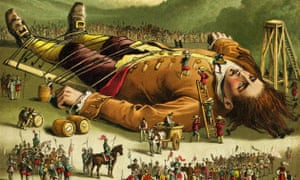The 100 greatest
novels of all time
No. 04
Gullivers's Travel
by Jonathan Swift
(1726)
Robert McCrum
Sunday 6 October 2013

On the island of Lilliput: a colour print from an 1860s edition of Gulliver’s Travels.
S
even years after the publication of Robinson Crusoe, the great Tory essayist and poet Jonathan Swift – inspired by the Scriblerus club, whose members included John Gay and Alexander Pope – composed a satire on travel narratives that became an immediate bestseller. According to Gay, Gulliver was soon being read “from the cabinet council to the nursery”.
In its afterlife as a classic, Gulliver’s Travels works on many levels. First, it’s a masterpiece of sustained and savage indignation, “furious, raging, obscene”, according to Thackeray. Swift’s satirical fury is directed against almost every aspect of early 18th-century life: science, society, commerce and politics. Second, stripped of Swift’s dark vision, it becomes a wonderful travel fantasy for children, a perennial favourite that continues to inspire countless versions, in books and films. Finally, as a polemical tour de force, full of wild imagination, it became a source for Voltaire, as well as the inspiration for a Telemann violin suite, Philip K Dick’s science-fiction story The Prize Ship, and, perhaps most influential of all, George Orwell’s Animal Farm.
Travels into Several Remote Nations of the World by Lemuel Gulliver (to give its original title) comes in four parts, and opens with Gulliver’s shipwreck on the island of Lilliput, whose inhabitant are just six inches high. The most famous and familiar part of the book (“Lilliputian” soon became part of the language) is a satirical romp in which Swift takes some memorable shots at English political parties and their antics, especially the controversy on the matter of whether boiled eggs should be opened at the big or the little end.
Next, Gulliver’s ship, the Adventure, gets blown off course and he is abandoned on Brobdingnag whose inhabitants are giants with a proportionately gigantic landscape. Here, having been dominant on Lilliput, Gulliver is exhibited as a curious midget, and has a number of local dramas such as fighting giant wasps. He also gets to discuss the condition of Europe with the King, who concludes with Swiftian venom that “the bulk of your natives [are] the most pernicious race of odious little vermin that Nature ever suffered to crawl upon the surface of the earth.”
In the third part of his travels, Gulliver visits the flying island of Laputa (a place-name also referenced in Stanley Kubrick’s film Dr Strangelove), and Swift mounts a dark and complicated assault on the speculations of contemporary science (notably spoofing the attempted extraction of sunbeams from cucumbers). Finally, in the section that influenced Orwell (Gulliver’s Travels was one of his favourite books), Swift describes the country of the Houyhnhnms, horses with the qualities of rational men. These he contrasts with the loathsome Yahoos, brutes in human shape. Orwell would later echo Swift’s misanthropy, looking ahead to a time “when the human race had finally been overthrown.”
At the end of it all, Gulliver returns home from his travels in a state of alienated wisdom, purged and matured by his experiences. “I write,” he concludes, “for the noblest end, to inform and instruct mankind… I write without any view to profit or praise. I never suffer a word to pass that may possibly give the least offence, even to those who are most ready to take it. So that I hope I may with justice pronounce myself an author perfectly blameless…”
When he died in 1745, Swift, remembered as “the gloomy Dean”, was buried in Dublin with the famous epitaph “ubi saeva indignatio ulterius cor lacerare nequit” (where fierce indignation can no further tear apart his heart) inscribed on his tomb.
A note on the text:
Swift probably started writing Gulliver’s Travels in 1720 (when Crusoe fever was at it height), and delivered the manuscript to the London publisher Benjamin Motte in March 1726. The book was published, anonymously, at top speed. Motte, who sensed a bestseller, used several presses to foil any attempt at piracy, and made many cuts to reduce the risk of prosecution. The first edition appeared, in two volumes, on 26 October 1726, priced 8s 6d, and sold out its first printing in less than a week. In 1735 the Irish publisher, George Faulkner printed a collection of Swift’s works. Volume III became Gulliver’s Travels, based on a working copy of the original manuscript. The textual history of Gulliver’s Travelsnow becomes incredibly complicated, and Swift later disowned most versions, including Motte’s first edition, saying it was so much altered that “I do hardly know mine own work”. Later scholarly editions of Swift have to choose between Motte and Faulkner, but whatever the version it has never been out of print since the day it first appeared.
Three more from Jonathan Swift
A Tale of a Tub (1704); A Modest Proposal, an essay (1729); Verses on the Death of Dr Swift (1739)



No comments:
Post a Comment